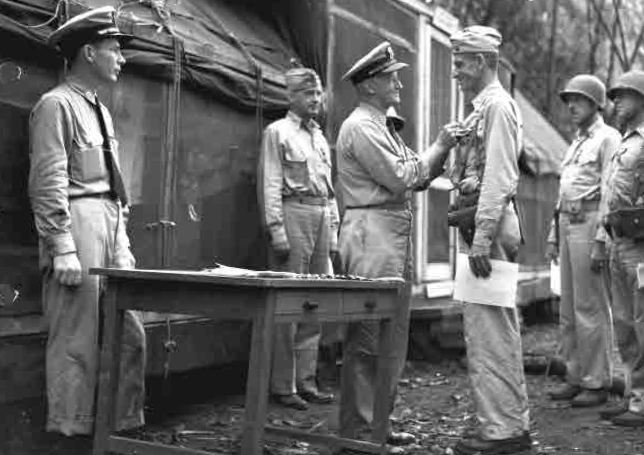Michael E. Haskew
The 1st and 2nd Raider Battalions, U.S. Marine Corps, which fought so bravely under Lieutenant Colonel Merritt A. “Red Mike” Edson and Lieutenant Colonel Evans F. Carlson at Guadalcanal were the embodiment of a noble experiment that began in the early days of World War II. The short-lived Marine Raiders, four of which were eventually formed, were sanctioned by Lieutenant General Thomas Holcomb, the Commandant of the Marine Corps, in February 1942.
Carlson builds the Marine Raiders

Carlson was the catalyst for the Marine Raiders. A veteran of the Army, he joined the Corps in 1939 and then left the service to warn the American people that war with Imperial Japan loomed in the near future. When he returned to the Marines, he brought with him the experience of observing the Chinese Communist army of Mao Tse-tung.
He was impressed with the esprit de corps that existed and the guerrilla tactics that the troops had honed to perfection. He also brought the mantra “Gung-ho!” which loosely translated into English as “Work together!”
During the 1930s, Carlson served with the Marine security detail at the Little White House in Warm Springs, Georgia, and he became friendly with President Franklin D. Roosevelt and his son James. After the U.S. entered World War II, Carlson approached the president for support for the Marine Raiders idea. The endorsement from the executive mansion and the fact that the president’s son, James, had become a Carlson devotee, helped make the concept a reality. After a thorough selection process, prospective members of the Rangers underwent rigorous training.
Fighting in the Solomons
.On August 17–18, 1942, while the 1st Battalion was fighting in the Solomons, Carlson led elements of the 2nd Battalion on a daring raid against Makin Atoll in the Gilbert Islands. During the fight 19 Marines were killed, and a rumor circulated that Carlson contemplated surrender. However, serious losses were inflicted on the Japanese garrison, and some useful intelligence was obtained. The results of the raid remain controversial and are debated to this day, the Makin Raid was touted as a great victory in the American press. The people were in need of heroes, and the Raiders fit the bill.
While 1st Battalion fought with distinction at Guadalcanal, Carlson brought the 2nd Battalion to the island in November 1942. After landing at Aola Bay, 30 miles (48km) beyond the established Marine defensive perimeter, these Raiders embarked on a month-long operation behind Japanese lines while engineers determined the feasibility of building a second airfield on the island near their initial landing point. The foray is remembered as the “Long Patrol”. The Raiders killed or wounded more than 500 enemy troops and lost 16 of their own, with 18 wounded.
Conflict between Marine Corps’ Officers
Although the Long Patrol was a resounding success, the days of the Marine Raiders were already numbered. While molding an effective fighting force, Carlson had engendered the enmity of numerous high-ranking Marine Corps’ officers. They resented the existence of an elite force within the Corps—itself already elite in their eyes. They believed Carlson had breached military protocol by taking advantage of his relationship with President Roosevelt. Circumventing the chain of command in getting the go-ahead to put the Raiders together.

The rumor of his supposed surrender overture at Makin dogged him. Perhaps worst of all, some considered him an outright Communist for his admiration of the Chinese and their principles of tactical warfare. After the Long Patrol, Carlson was sent home to be treated for malaria and to consult on movies about the Raiders’ exploits. Shunted to staff positions, he never again served with the Raiders.
Marine bravery at the battle of Tarawa
In November 1943, he was allowed to participate in the landings on Tarawa Atoll in the Gilberts as an observer. He fought bravely during the four-day battle, prompting Colonel David Shoup, commander of the 2nd Marines, to remark, “He may be Red, but he isn’t Yellow.”
Two additional Raider battalions were formed in the autumn of 1942. Raider formations later reorganized into two regiments. By early 1944, however, the character of the war in the Pacific had changed. There seemed to be little need for light infantry to perform deep penetration missions, while the formation of new Marine combat divisions required all available manpower.
Evans Carlson went ashore with the Marines again at Saipan in 1944 and suffered a serious wound while saving the life of another man. He died of a heart attack at the age of 51 on May 27, 1947.
Michael E. Haskew is the editor of WWII History Magazine and the former editor of World War II Magazine . He is the author of a number of books, including THE MARINES IN WORLD WAR II. The Sniper at War and Order of Battle. Haskew is also the editor of The World War II Desk Reference with the Eisenhower Center for American Studies. He lives in Hixson, Tennessee.
